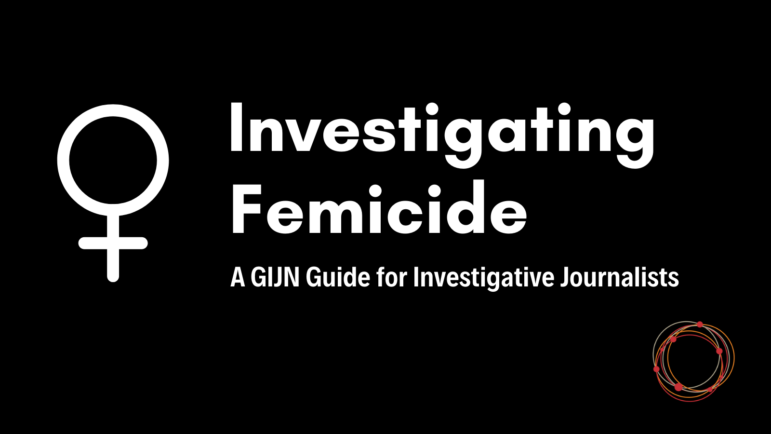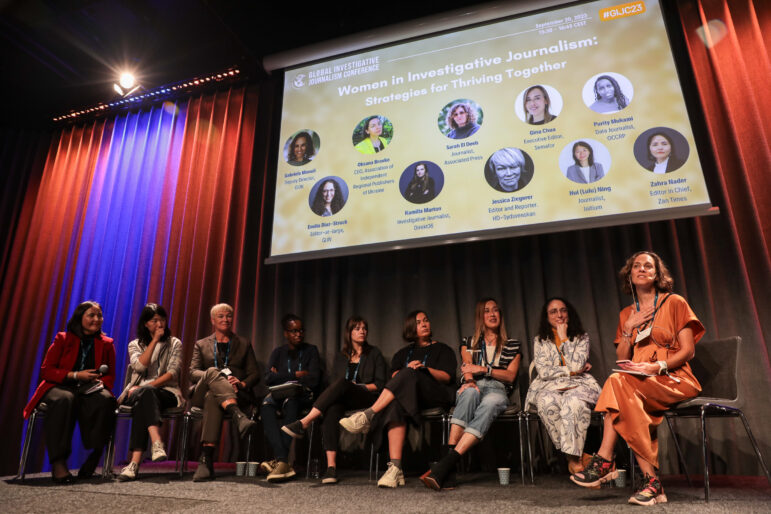

A panel discussing investigations into femicide at GIJC23. Image: Smaranda Tolosano for GIJN
Humanizing without Sensationalizing: Investigating Femicide
Read this article in
Reporting on femicide — the deliberate killing of women because they are women — is often framed around salacious and gruesome details, or relies solely upon hard data to illustrate the number of women killed.
So how can journalists do better when reporting on this critical issue, and use data without reducing the murder of women to crime statistics, and how can they produce a narrative that humanizes but does not sensationalize? During a panel at the 13th Global Investigative Journalism Conference (#GIJC23), Mago Torres, data editor at The Examination, talked with four reporters how to strike a balance between statistics and personal narrative to produce powerful storytelling about the issue of femicide.
Structural Problem
For the investigation Justicia Machista (“Sexist Justice”), Fabiola Torres and her team at Peru-based Salud con Lupa filed FOI requests to access court records and compile a database of 160 court decisions on femicide and attempted femicide between 2018 and 2022.
They found that phrases extracted from court decisions showed that judges’ rationales often mirrored the narrative and arguments presented by the defense lawyers of the accused, which included arguments for reducing allegations of femicide, or attempted femicide, to lesser crimes, such as physical injury. One example was the reasoning that because wounds were not in critical areas of a woman’s body, there had been no intention to kill her.
When handing down convictions, the Salud con Lupa reporters noted, the courts often did not impose the sentences for such crimes outlined in the penal code. Some of the judges’ reasoning was that if the convicted was a young man with children to care for and was still of a “productive age,” his crime did not merit life imprisonment.
The investigation revealed an “uncomfortable truth,” said Torres. “The profile of [a person who commits] femicide is an ordinary man who has ingrained sexist behavior.” Society tends to reduce the problem of gender violence to a group of “bad men” — but it’s not true, she added. “This is a structural problem.”
The findings of the investigation were shared with Peruvian judges — including the gender justice commission of the judiciary — to better understand the gaps and inconsistencies in the judicial system.
Torres said that when investigating femicide, journalists should look beyond the number of women killed and search for trends. For instance, Torres and her team noted that approximately one in seven victims of femicide in 2021 had initially been reported as missing: “First comes disappearance, then femicide,” said Torres.
‘Staggering’ Shortage of Data
Janine Louloudi, a journalist and producer at the Mediterranean Institute of Investigative Reporting (MIIR) led a cross-border investigation across 19 newsrooms to map out the state of violence and femicide across Europe during the COVID-19 pandemic. Femicides: The Undeclared War on Women in Europe revealed the “staggering” shortage of current data on femicides.
According to the investigation, there is no official data about femicide at a European Union level after 2018, and throughout Europe, only Cyprus identifies the specific crime of femicide, as distinct from homicide, in its legal system. Recently, Malta introduced a clause for “femicidal intent” for murders against women. The team collected data from regional sources such as the European Institute for Gender Equality (EIGE), and state-level sources such as national statistics and police data. Data from unofficial sources, such as local monitoring groups, were also included.

Read GIJN’s Guide to Investigating Femicide, which has information about finding and understanding data. Image: GIJN
Interviews with survivors and family members of victims were crucial to counter the sensationalist reporting of femicide as crimes of passion. “Every statistic is a moment in time when the life of a woman changes,” said Louloudi.
Louloudi and Thanasis Troboukis — a journalist at the Athens-based media development nonprofit iMEdD Lab who took charge of data analysis and visualizations for the cross-border story — shared tips for collecting data and making meaningful comparisons.
- Visualize the missing data. Once data is compiled, Trobouki suggested analyzing data gaps before diving into the analysis to “get an overall picture of what you can and cannot do.”
- Focus on rates, not just absolute numbers. Collecting data from different countries will mean disparities in data collection methodologies and calculations. Calculate percentage changes to making meaningful comparisons.
- Use general statistical data to make comparisons. Comparing data on femicide to statistics like population will contextualize the incidence of female murders against the overall population.
- Examine how data illustrates the survivor’s journey. For instance, a victim may try to call a helpline. Try to find how many calls are recorded, said Troboukis. Additionally, a woman may file a complaint, so analyzing the number of complaints and the types of violence reported can illustrate how many of these actually result in an arrest and convictions.
- Other questions to think about: Does your country recognize intimate partner violence? What are existing laws that frame violence against women? What is the age of the victims? What is the sex of the victims?
In the case of South Africa, the absence of data on femicide was the first obstacle Laura Grant and her team at the Media Hack Collective encountered; crime data released annually counts only the number of murders, without a breakdown into men and women.
A South African Police Service (SAPS) PowerPoint presentation based on 2019-20 crime data did include information on the relationship between victim and killer, but this was known in only about one of five murder cases — for both men and women victims — that year.
To fill in the gaps and tell some of these stories, Grant’s team compiled news reports about women being killed, and created an interactive map of where the killings occurred — but even some news articles lacked information about the victims and their causes of death. Those missing details, Grant explained, were the reason they decided to title their data investigation #SayHerName: The Faces of South Africa’s Femicide Epidemic. (Further details on their methodology for researching news stories are available here.)
According to the SAPS data cited in their investigation, between 2015 and 2020 a total of 13,815 women were murdered — or about seven women each day. Looking at news reports from January 2018 to October 2020, Grant explained, they found that from the number of women 18 and older who were killed in that time period, only a small fraction of cases had been featured on national or local news.
“Media stories [about femicide] are often about young, pretty women, or celebrities. The details are salacious or gruesome,” said Grant, who added that most of the stories that are eventually made public come out during commemorative days calling for an end to violence against women.
“There are a whole lot of stories of women that aren’t told. And the fact that these stories aren’t told is just as important,” Grant added.









